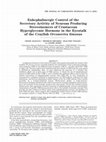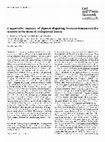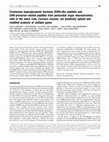Papers by Heinrich Dircksen

J Comp Neurol, 2002
A subgroup of neurons in the classical X-organ-sinus gland neuroendocrine system of the crayfish ... more A subgroup of neurons in the classical X-organ-sinus gland neuroendocrine system of the crayfish (Orconectes limosus) eyestalk produces two chiral forms of the crustacean hyperglycemic hormone (CHH) in two different types of neurons: CHH in ϳ22 cells and D-Phe 3 CHH in eight cells. Previous reports have demonstrated that release of CHH from the sinus gland is inhibited by enkephalins. Here, we have addressed the questions of 1) whether this inhibition affects one or both types of CHH neurons, 2) where the site of enkephalinergic control of CHH and/or D-Phe 3 CHH is, and 3) whether the inhibitory effect is due to direct or indirect interactions of enkephalinergic neurons with CHH cells. In vitro incubations of neurosecretory complexes followed by immunoassays of CHH isoforms indicated that both methionine-and leucine-enkephalins inhibit release of the two CHH isoforms from crayfish eyestalks, by a receptor-mediated process. Whole-mount double-or triple-immunofluorescence labelings combined with confocal microscopy revealed enkephalin immunostaining in all neuropils of the eyestalk, except in the sinus gland. Virtual thin confocal sections showed many close appositions between terminals of enkephalinergic neurons and dendritic arborizations of specific CHH-immunoreactive cells in the medulla terminalis neuropil. This provides the first evidence for direct inputs from enkephalinergic neurons into dendrites of both CHH cell types, which suggests that enkephalins inhibit release of both CHH isoforms via synaptic contacts.

Cell and Tissue Research, Nov 1, 1991
In a comparative study, the anatomy of neurons immunoreacfive with an antiserum against the crust... more In a comparative study, the anatomy of neurons immunoreacfive with an antiserum against the crustacean r-pigment-dispersing hormone was investigated in the brain of several orthopteroid insects including locusts, crickets, a cockroach, and a phasmid. In all species studied, three groups of neurons with somata in the optic lobes show pigment-dispersing hormone-like immunoreactivity. Additionally, in most species, the tritocerebrum exhibits weak immunoreactive staining originating from ascending fibers, tritocerebral cells, or neurons in the inferior protocerebrum. Two of the three cell groups in the optic lobe have somata at the dorsal and ventral posterior edge of the lamina. These neurons have dense ramifications in the lamina with processes extending into the first optic chiasma and into distal layers of the medulla. Pigment-dispersing hormone-immunoreactive neurons of the third group have somata near the anterior proximal margin of the medulla. These neurons were reconstructed in Schistocerca gregaria, Locusta rnigratoria, Teleogryllus cornrnodus, Periplaneta americana, and Extatosorna tiaraturn. The neurons have wide and divergent arborizations in the medulla, in the lamina, and in several regions of the midbrain, including the superior and inferior lateral protocerebrum and areas between the pedunculi and e-lobes of the mushroom bodies. Species-specific differences were found in this third cell group with regard to the number of immunoreactive cells, midbrain arborizafions, and contralateral projections, which are especially prominent in the cockroach and virtually absent in crickets. The unusual branching patterns and the special neurochemical phenotype suggest a particular physiological role of these neurons. Their possible function as circadian pacemakers is discussed.
Brain Research, Dec 1, 1991
We have recently shown that the amyloid beta A4 precursor protein (APP) is synthesized in neurons... more We have recently shown that the amyloid beta A4 precursor protein (APP) is synthesized in neurons and undergoes fast axonal transport to synaptic sites [Koo et al., Proc. Natl. Acad. Sci. U.S.A., 87 (1990) 1561-1565]. Using immunofluorescence, laser confocal microscopy and immunoelectron microscopy with simultaneous detection of APP and synaptophysin, we now report a preferential localization of APP at synaptic sites of human and rat brain and at neuromuscular junctions. APP is further found on vesicular elements of neuronal perikarya, dendrites and axons. The synaptic localization of APP implies (1) a role of APP in physiological synaptic activity and (2) a potential and early impairment of central synapses when synaptic APP is converted to beta A4 amyloid during the pathological evolution of Alzheimer's disease and Down's syndrome.
ABSTRACT Research on crustacean peptides has concentrated mainly on decapods and isopods, and a g... more ABSTRACT Research on crustacean peptides has concentrated mainly on decapods and isopods, and a growing number of >200 peptides have been sequenced from these two groups, the majority from decapods, but recently, the annotation of the Daphnia pulexgenome has contributed many more novel peptides many of which were also sequenced de novo. Identified and bioactive crustacean peptides — the only ones reported here — regulate a large range of physiological functions, including color change, activities of heart, exoskeletal and visceral muscles, metabolic function, development, metamorphosis, and reproduction.

Biochemical Journal, May 15, 2001
About 24 intrinsic neurosecretory neurons within the pericardial organs (POs) of the crab Carcinu... more About 24 intrinsic neurosecretory neurons within the pericardial organs (POs) of the crab Carcinus maenas produce a novel crustacean hyperglycaemic hormone (CHH)-like peptide (PO-CHH) and two CHH-precursor-related peptides (PO-CPRP I and II) as identified immunochemically and by peptide chemistry. Edman sequencing and MS revealed PO-CHH as a 73 amino acid peptide (8630 Da) with a free C-terminus. PO-CHH and sinus gland CHH (SG-CHH) share an identical N-terminal sequence, positions 1-40, but the remaining sequence, positions 41-73 or 41-72, differs considerably. PO-CHH may have different precursors, as cDNA cloning of PO-derived mRNAs has revealed several similar forms, one exactly encoding the peptide. All PO-CHH cDNAs contain a nucleotide stretch coding for the SG-CHH(41-76) sequence in the 3'-untranslated region (UTR). Cloning of crab testis genomic DNA revealed at least four CHH genes, the structure of which suggest that PO-CHH and SG-CHH arise by alternative splicing of precursors and possibly post-transcriptional modification of PO-CHH. The genes encode four exons, separated by three variable introns, encoding part of a signal peptide (exon I), the remaining signal peptide residues, a CPRP, the PO-CHH(1-40)/SG-CHH(1-40) sequences (exon II), the remaining PO-CHH residues (exon III) and the remaining SG-CHH residues and a 3'-UTR (exon IV). Precursor and gene structures are more closely related to those encoding related insect ion-transport peptides than to penaeid shrimp CHH genes. PO-CHH neither exhibits hyperglycaemic activity in vivo, nor does it inhibit Y-organ ecdysteroid synthesis in vitro. From the morphology of the neurons it seems likely that novel functions remain to be discovered.

Journal of Experimental Biology, Oct 1, 2006
ABSTRACT Full-length cDNAs encoding crustacean cardioactive peptide (CCAP) were isolated from sev... more ABSTRACT Full-length cDNAs encoding crustacean cardioactive peptide (CCAP) were isolated from several decapod (brachyuran and astacuran) crustaceans: the blue crab Callinectes sapidus, green shore crab Carcinus maenas, European lobster Homarus gamarus and calico crayfish Orconectes immunis. The cDNAs encode open reading frames of 143 (brachyurans) and 139-140 (astacurans) amino acids. Apart from the predicted signal peptides (30-32 amino acids), the conceptually translated precursor codes for a single copy of CCAP and four other peptides that are extremely similar in terms of amino acid sequence within these species, but which clearly show divergence into brachyuran and astacuran groups. Expression patterns of CCAP mRNA and peptide were determined during embryonic development in Carcinus using quantitative RT-PCR and immunohistochemistry with whole-mount confocal microscopy, and showed that significant mRNA expression (at 50% embryonic development) preceded detectable levels of CCAP in the developing central nervous system (CNS; at 70% development). Subsequent CCAP gene expression dramatically increased during the late stages of embryogenesis (80-100%), coincident with developing immunopositive structures. In adult crabs, CCAP gene expression was detected exclusively in the eyestalk, brain and in particular the thoracic ganglia, in accord with the predominance of CCAP-containing cells in this tissue. Measurement of expression patterns of CCAP mRNA in Carcinus and Callinectes thoracic ganglia throughout the moult cycle revealed only modest changes, indicating that previously observed increases in CCAP peptide levels during premoult were not transcriptionally coupled. Severe hypoxic conditions resulted in rapid downregulation of CCAP transcription in the eyestalk, but not the thoracic ganglia in Callinectes, and thermal challenge did not change CCAP mRNA levels. These results offer the first tantalising glimpses of involvement of CCAP in environmental adaptation to extreme, yet biologically relevant stressors, and perhaps suggest that the CCAP-containing neurones in the eyestalk might be involved in adaptation to environmental stressors.
Cell Tissue Res, 1987
Summary. By use of a new antiserum, raised against syn-thetic pigment-dispersing hormone (PDH) fr... more Summary. By use of a new antiserum, raised against syn-thetic pigment-dispersing hormone (PDH) from Uca pugila-tor, immunoreactive structures were studied at the light-microscopic level in the eyestalk ganglia of Carcinus maenas and Orconectes limosus. PDH-reactivity ...
ABSTRACT Bioassays of visceral muscles in decapod crustaceans have been used to identify bioactiv... more ABSTRACT Bioassays of visceral muscles in decapod crustaceans have been used to identify bioactive peptides from neurohaemal pericardial organs (POs) or nervous systems. PO-peptides such as proctolin, FLRFa-related peptides (FaRPs) and CCAP affect heart beat and ventilatory activity, and using hindgut bioassays (even insect hindguts) helped to discover further myoactive FaRPs, orcokinins, orcomyotropin and members, e.g., of tachykinin, myokinin, sulfakinin and allatostatin peptide families. Immunocytochemistry revealed wide distributions of the peptides in neurosecretory neurones and interneurones of the CNS and peripheral nervous systems indicative of several neuronal activities, some of which have been established on e.g. stomatogastric ganglion (STG) or nerve-(skeletal) muscle preparations.

Cell and Tissue Research, 2009
We have examined the development of pigmentdispersing hormone (PDH)-immunoreactive neurons in emb... more We have examined the development of pigmentdispersing hormone (PDH)-immunoreactive neurons in embryos of the American lobster Homarus americanus Milne Edwards, 1837 (Decapoda, Reptantia, Homarida) by using an antiserum against β-PDH. This peptide is detectable in the terminal medulla of the eyestalks and the protocerebrum where PDH immunoreactivity is present as early as 20% of embryonic development. During ontogenesis, an elaborate system of PDH-immunoreactive neurons and fibres develops in the eyestalks and the protocerebrum, whereas less labelling is present in the deuto-and tritocerebrum and the ventral nerve cord. The sinus gland is innervated by PDH neurites at hatching. This pattern of PDH immunoreactivity has been compared with that found in various insect species. Neurons immunoreactive to pigment-dispersing factor in the medulla have been shown to be a central component of the system that generates the circadian rhythm in insects. Our results indicate that, in view of the position of the neuronal somata and projection patterns of their neurites, the immunolabelled medulla neurons in insects have homologous counterparts in the crustacean eyestalk. Since locomotory and other activities in crustaceans follow distinct circadian rhythms comparable with those observed in insects, we suggest that PDHimmunoreactive medulla neurons in crustaceans are involved in the generation of these rhythms.

Environmental science & technology, Jan 29, 2016
Selective serotonin reuptake inhibitors (SSRIs) are widely used antidepressants. As endocrine dis... more Selective serotonin reuptake inhibitors (SSRIs) are widely used antidepressants. As endocrine disruptive contaminants in the environment, SSRIs affect reproduction in aquatic organisms. In the water flea Daphnia magna, SSRIs increase offspring production in a food ration-dependent manner. At limiting food conditions, females exposed to SSRIs produce more but smaller offspring, which is a maladaptive life-history strategy. We asked whether increased serotonin levels in newly identified serotonin-neurons in the Daphnia brain mediate these effects. We provide strong evidence that exogenous SSRI fluoxetine selectively increases serotonin-immunoreactivity in identified brain neurons under limiting food conditions thereby leading to maladaptive offspring production. Fluoxetine increases serotonin-immunoreactivity at low food conditions to similar maximal levels as observed under high food conditions and concomitantly enhances offspring production. Sublethal amounts of the neurotoxin 5,7-d...
Peptides, Jul 1, 1988
A radioimmunoassay (RIA) for the recently discovered crustacean cardioactive peptide (CCAP) has b... more A radioimmunoassay (RIA) for the recently discovered crustacean cardioactive peptide (CCAP) has been developed and used to determine contents of CCAP in different parts of the nervous system of the shore crab Carcinus maenas. Immunoreactive material was detected throughout the nervous system. In contrast to the main ganglia which contained low levels of approximately 1.4 pmol CCAP/mg protein (brain and thoracic ganglion), a high concentration was found in a neurohemal structure, the pericardial organs (PO) (868 pmol/mg protein). A predominantly neurohormonal role of CCAP thus suggested is further supported by in vitro release studies. Incubation of POs in high (K+) saline showed that CCAP is secretable in considerable amounts by a Ca++-dependent release mechanism.

Cell and Tissue Research, Jan 31, 1997
Crustacean hyperglycaemic hormone-immunoreactive neuronal systems are detected in the central and... more Crustacean hyperglycaemic hormone-immunoreactive neuronal systems are detected in the central and peripheral nervous systems of two entomostracan crustaceans, Daphnia magna and Artemia salina, by immunocytochemistry using specific antisera against crustacean hyperglycaemic hormones of the decapod crustaceans Orconectes limosus and Carcinus maenas. In D. magna, four small putative interneurones are detected in the brain. In the thorax, ten bipolar peripheral neurones are stained by both antisera. They are obviously segmental homologues with centrally projecting axons that form interdigitating varicose fibres and terminals in putative neurohaemal areas next to the surface of the anterior part of the thoracic ganglia. Similar immunopositive neurones occur both in the central and peripheral nervous systems of A. salina. A total of five groups of neurones occur in the protocerebrum, the deutocerebrum and the mandibular ganglion. Some of the protocerebral neurones are bipolar and project to the dorsal frontal organ. A single pair of peripheral multipolar neurones in the maxillary segment projects centrally into the ventral nerve cord and innervates unidentified somatic muscles and tissues in the maxillary and the first appendage segments. None of the brain neurones in both species show similarities to decapod X-organ sinus gland neurosecretory neurones. Chromatography of brain extracts of D. magna combined with immunodot blotting revealed two strongly immunoreactive fractions at retention times close to that of the crustacean hyperglycaemic hormone of crayfish. Moreover, preabsorption controls suggest that the cross-reacting peptides of D. magna and A. salina are structurally closely related to those of decapods.

Cell and Tissue Research, 2015
We reveal the neuroanatomy of the optic ganglia and central brain in the water flea Daphnia magna... more We reveal the neuroanatomy of the optic ganglia and central brain in the water flea Daphnia magna by use of classical neuroanatomical techniques such as semi-thin sectioning and neuronal backfilling, as well as immunohistochemical markers for synapsins, various neuropeptides and the neurotransmitter histamine. We provide structural details of distinct neuropiles, tracts and commissures, many of which were previously undescribed. We analyse morphological details of most neuron types, which allow for unravelling the connectivities between various substructural parts of the optic ganglia and the central brain and of ascending and descending connections with the ventral nerve cord. We identify 5 allatostatin-A-like, 13 FMRFamide-like and 5 tachykinin-like neuropeptidergic neuron types and 6 histamine-immunoreactive neuron types. In addition, novel aspects of several known pigment-dispersing hormone-immunoreactive neurons are re-examined. We analyse primary and putative secondary olfactory pathways and neuronal elements of the water flea central complex, which displays both insect- and decapod crustacean-like features, such as the protocerebral bridge, central body and lateral accessory lobes. Phylogenetic aspects based upon structural comparisons are discussed as well as functional implications envisaging more specific future analyses of ecotoxicological and endocrine disrupting environmental chemicals.

Crustacean hyperglycaemic hormone (CHH)-like peptides and CHH-precursor-related peptides from per... more Crustacean hyperglycaemic hormone (CHH)-like peptides and CHH-precursor-related peptides from pericardial organ neurosecretory cells in the shore crab, Carcinus maenas, are putatively spliced and About 24 intrinsic neurosecretory neurons within the pericardial organs (POs) of the crab Carcinus maenas produce a novel crustacean hyperglycaemic hormone (CHH)-like peptide (PO-CHH) and two CHH-precursor-related peptides (PO-CPRP I and II) as identified immunochemically and by peptide chemistry. Edman sequencing and MS revealed PO-CHH as a 73 amino acid peptide (8630 Da) with a free C-terminus. PO-CHH and sinus gland CHH (SG-CHH) share an identical N-terminal sequence, positions 1-40, but the remaining sequence, positions 41-73 or 41-72, differs considerably. PO-CHH may have different precursors, as cDNA cloning of PO-derived mRNAs has revealed several similar forms, one exactly encoding the peptide. All PO-CHH cDNAs contain a nucleotide stretch coding for the SG-CHH%" -(' sequence in the 3h-untranslated region (UTR). Cloning of crab testis genomic DNA revealed at least four CHH genes, the structure of which suggest that PO-CHH and SG-CHH arise by alternative splicing of precursors and possibly post-transcriptional modification of PO-CHH. The genes encode four exons, separated by three variable introns, encoding part of a signal peptide (exon I), the remaining signal peptide residues, a CPRP, the PO-CHH" -%!\SG-CHH" -%! sequences (exon II), the remaining PO-CHH residues (exon III) and the remaining SG-CHH residues and a 3h-UTR (exon IV). Precursor and gene structures are more closely related to those encoding related insect ion-transport peptides than to penaeid shrimp CHH genes. PO-CHH neither exhibits hyperglycaemic activity in i o, nor does it inhibit Y-organ ecdysteroid synthesis in itro. From the morphology of the neurons it seems likely that novel functions remain to be discovered.

Uploads
Papers by Heinrich Dircksen